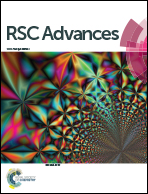Tuning the photoluminescence and ultrasensitive trace detection properties of few-layer MoS2 by decoration with gold nanoparticles
Abstract
We report an easy and inexpensive chemical route for the decoration of few-layer MoS2 with Au nanoparticles (NPs). The Au-NPs are formed on the defect sites of the MoS2 and localized by a non-covalent bond. The NPs act as a p-type dopant in the MoS2 layer. An enhancement in the photoluminescence (PL) intensity of the Au–MoS2 composite with respect to bare few-layer MoS2 has been observed. We also systematically observed a blue shift in the excitonic emission as the number and size of the Au-NPs on MoS2 increased. Both phenomena have been understood to result from the switching between charged exciton (trion) recombination and neutral exciton recombination. A potential application for the Au–MoS2 composite has been demonstrated, by using it as a substrate for surface-enhanced Raman scattering (SERS). The SERS measurements show a uniform, reproducible, and strong Raman signal from the adsorbed molecules with concentrations as low as 10−12 M. Our work provides a method to tune the optical and electronic properties of MoS2, and the Au–MoS2 composite might be useful as an efficient SERS substrate for the ultrasensitive detection of biomolecules.


 Please wait while we load your content...
Please wait while we load your content...